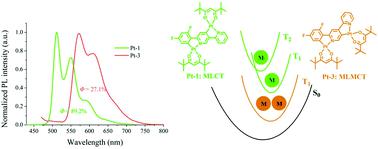当前位置:
X-MOL 学术
›
Dalton Trans.
›
论文详情
Our official English website, www.x-mol.net, welcomes your
feedback! (Note: you will need to create a separate account there.)
More efficient spin-orbit coupling: adjusting the ligand field strength to the second metal ion in asymmetric binuclear platinum(ii) configurations.
Dalton Transactions ( IF 3.5 ) Pub Date : 2020-06-04 , DOI: 10.1039/d0dt00939c Zhaoran Hao 1 , Kai Zhang , Kuan Chen , Pu Wang , Zhiyun Lu , Weiguo Zhu , Yu Liu
Dalton Transactions ( IF 3.5 ) Pub Date : 2020-06-04 , DOI: 10.1039/d0dt00939c Zhaoran Hao 1 , Kai Zhang , Kuan Chen , Pu Wang , Zhiyun Lu , Weiguo Zhu , Yu Liu
Affiliation

|
Two types of asymmetric binuclear platinum(II) complexes (Pt-1 and Pt-3) bearing bridging ligands of 2-(2,4-difluorophenyl)-5-(pyridin-2-yl)pyridine and 2-(2,4-difluorophenyl)-4-(pyridin-2-yl)pyridine as well as their corresponding mononuclear counterparts (Pt-2, Pt-4, and Pt-5) were synthesized and characterized. Different chelating constructions of the second platinum(II) ions and the bridging ligands in Pt-1 and Pt-3 gave rise to two kinds of electron-transition pathway during their photophysical processes. The meta-/para-carbon of nitrogen on the center pyridyl segments set different levels of ligand field strength to the second platinum(II) ions, lowering their occupied d orbital to varying degrees. Pt-1 showed an enhanced spin–orbit coupling (SOC), caused by the additional metal component through direct orbital hybridization at higher states, where the fixed molecular skeleton induced by the additional metal–ligand bonding also helped to suppress molecular distortion in the excited state, ensuring a high quantum yield (Φ, 0.89 in toluene), which is among the best results in bimetallic complexes. While the second platinum(II) ion in Pt-3 seemed to make no contribution to the radiative transition, and only contributed to the HOMO, it provided a benefit by enlarging the conjugate system. Solution-processed organic lighting emitting devices (OLEDs) fabricated with the bimetallic Pt-1 emitter achieved superior efficiencies and up to 21% external quantum efficiency (EQE) in the Kelly-green region.
中文翻译:

更有效的自旋轨道耦合:在不对称双核铂(ii)构型中将配体场强调节至第二种金属离子。
带有2-(2,4-二氟苯基)-5-(吡啶-2-基)吡啶和2-(2,4)桥连配体的两种不对称双核铂(II)配合物(Pt-1和Pt-3)合成并表征了-二氟苯基)-4-(吡啶-2-基)吡啶及其相应的单核对应物(Pt-2,Pt-4和Pt-5)。Pt-1和Pt-3中第二个铂(II)离子和桥联配体的不同螯合结构在其光物理过程中产生了两种电子跃迁途径。中心吡啶基段上氮的间位碳原子/对位碳原子对第二个铂(II)设置不同水平的配体场强)离子,不同程度地降低了其占据的d轨道。Pt-1表现出增强的自旋-轨道耦合(SOC),这是由于其他金属组分通过在较高状态下直接进行轨道杂交而引起的,其中由附加金属-配体键合诱导的固定分子骨架也有助于抑制受激分子的畸变。态,确保高量子产率(甲苯中Φ为0.89),这是双金属络合物的最佳结果之一。而第二白金(二)Pt-3中的离子似乎对辐射跃迁没有任何贡献,而仅对HOMO有贡献,它通过扩大共轭体系提供了好处。用双金属Pt-1发射器制造的溶液处理有机发光器件(OLED)在凯利绿色区域实现了卓越的效率,并达到了21%的外部量子效率(EQE)。
更新日期:2020-06-29
中文翻译:

更有效的自旋轨道耦合:在不对称双核铂(ii)构型中将配体场强调节至第二种金属离子。
带有2-(2,4-二氟苯基)-5-(吡啶-2-基)吡啶和2-(2,4)桥连配体的两种不对称双核铂(II)配合物(Pt-1和Pt-3)合成并表征了-二氟苯基)-4-(吡啶-2-基)吡啶及其相应的单核对应物(Pt-2,Pt-4和Pt-5)。Pt-1和Pt-3中第二个铂(II)离子和桥联配体的不同螯合结构在其光物理过程中产生了两种电子跃迁途径。中心吡啶基段上氮的间位碳原子/对位碳原子对第二个铂(II)设置不同水平的配体场强)离子,不同程度地降低了其占据的d轨道。Pt-1表现出增强的自旋-轨道耦合(SOC),这是由于其他金属组分通过在较高状态下直接进行轨道杂交而引起的,其中由附加金属-配体键合诱导的固定分子骨架也有助于抑制受激分子的畸变。态,确保高量子产率(甲苯中Φ为0.89),这是双金属络合物的最佳结果之一。而第二白金(二)Pt-3中的离子似乎对辐射跃迁没有任何贡献,而仅对HOMO有贡献,它通过扩大共轭体系提供了好处。用双金属Pt-1发射器制造的溶液处理有机发光器件(OLED)在凯利绿色区域实现了卓越的效率,并达到了21%的外部量子效率(EQE)。











































 京公网安备 11010802027423号
京公网安备 11010802027423号